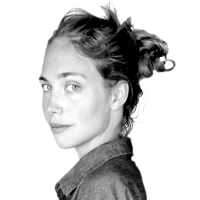There is something perverse about attaching the word “celebrity” to Joan Didion, the beloved personal essayist, revolutionary New Journalist, and gimlet-eyed cultural critic. (And latterly, Céline model.)
So much of her writing is, after all, about the illusions of self-deception, dismantling American legends, and exposing the fragility behind the powerful public persona.
It seems astonishing that, given her standing and given the fascination with her, there hasn't been a biography of her yet--until now, with Tracy Daugherty's literally weighty The Last Love Song: A Biography of Joan Didion.
It is the first biography of Didion, now 80, who did not cooperate with the author. Neither did many of the people who are closest to her.
Daugherty, who has written biographies of Joseph Heller and Donald Barthelme, is forthcoming from the beginning about being denied access to Didion.
“There is the biographer who promises explanations by threatening to reveal a subject’s secrets, who promises to dish,” Daugherty writes. “I am not that biographer.”
There’s no denying that Didion has become a literary celebrity, a writer whose most oft-quoted sentence on social media—“We tell ourselves stories in order to live”—is her most hackneyed.
This is the opening line of the titular essay in her 1979 collection, The White Album, and the title of a forthcoming documentary by her niece and nephew.
But in the context of social media memes, one imagines it interpreted too literally by people who subscribe to the cult of Joan Didion—the fashionable and elusive cool girl in the white Corvette—but have never read The White Album.
If they did read it, they would quickly discover that the opening sentence (and the essay itself) is not about the vital importance of stories, in the sense that they nourish and inspire us. It’s about self-deception, how we “interpret what we see, select the most workable of multiple choices.”
It’s about how Didion had “mislaid” the “script” when trying to make narrative sense of the apocalyptic chaos that characterized the 1960s.
Her neurological disorder (“vertigo and nausea”) and the chaos of that time leads her to determine that “all narrative was sentimental,” that all connections “were equally meaningful, and equally senseless.”
Life, as Didion sees it, cannot be reduced to aphorisms, and Didion never employed them in her writing.
That’s the trouble with being a literary celebrity: She is invariably perceived to be representative of the time that she lived in, and is often reduced to an archetype or an image or a word.
For Didion, the archetype is the neurotic and hermetic writer; the image is the stylish, aloof woman in the Corvette, a cigarette dangling from her hand; the word is “cool.”
In his attempt to determine the real writer from celebrity archetype, Daughtery delivers rigorous research and literary criticism to determine whether “the life reveal[s] the art, or the art the life.”
Daugherty examines the evolution of Didion’s writing style, from her early career in New York at Vogue, when she wrote many of her most famous and beloved personal essays (“On Self Respect” and “Goodbye to All That,” beloved particularly by young writers) to her cutting political profiles (“Pretty Nancy,” on then-First Lady Nancy Reagan) and her heartbreaking memoirs (The Year of Magical Thinking and Blue Nights, in which she “flagellates herself for being a bad mother,” Daugherty writes).
Mostly, Daugherty shows us the personal, social, and political contexts of Didion’s earlier essays for Vogue and The Saturday Evening Post, later published in her seminal nonfiction collection Slouching Towards Bethlehem, which put her on the map as a critically celebrated writer and pioneer of New Journalism.
Daugherty gives us 600 pages of excellent literary criticism and painstaking detail about her personal life, including her turbulent relationship with her husband, fellow writer John Gregory Dunne, and her adopted daughter, Quintana Roo, who was diagnosed with multiple personality disorder (though Didion never fully accepted the diagnosis).
Didion wrote about Dunne in The Year of Magical Thinking, a 2005 memoir about his sudden death and her bestselling book to date; she wrote about Quintana Roo, who died not long after Dunne of complications from pneumonia, in Blue Nights (2011).
Daugherty reveals little that Didion has not already revealed in her own writing, and in that sense the biography fails.
One of the only first-person interviews Daugherty manages to get is with Noel Parmentel, an early boyfriend of Didion’s now in his 80s, who was influential in her early career: He introduced her to editors at The Saturday Evening Post and National Review. He also introduced her to Dunne in 1958, telling her, “This is the guy you ought to marry.”
Didion has always been careful not to reveal too much about herself personally in her books. She always keeps some distance. Daugherty, alas, was unable to tell us what she hasn’t divulged.
While critics have often pigeonholed Didion as politically conservative until later in life, Daugherty writes that she “is not always easy to understand, ideologically.”
He didn’t interview her longtime editor at the New York Times Book Review, Robert Silvers, who discovered Didion’s writing in the early 1970s.
But Daugherty does quote Silvers telling another journalist that Didion is “by no means an equally classifiable liberal or conservative, she is interested in whether or not people are morally evasive, smug, manipulative, or cruel—those qualities of moral action are very central to all her political work.”
With nothing emanating directly from its subject, much of The Last Love Song inevitably rehashes a lot of what Didion wrote herself, but Daugherty grounds our understanding of the writer in her background as a child raised in California by a Republican family who ingrained in her the myth of the pioneering American spirit, or what Didion called the “crossing story as origin myth.”
Didion was always attuned to the ways that myth informed the world and her writing, and the ways that it would eventually let her down.
Didion has also always been critical of American legends, but it wasn’t until her later years that she became critical of the legend that formed around who she was.
The irony, as Daugherty illustrates, is that Didion has long since become a legend herself—and a purposefully enigmatic one at that who remains determined to resist the revelation-hunting, definitive-portrait-seeking instincts of her biographers.






